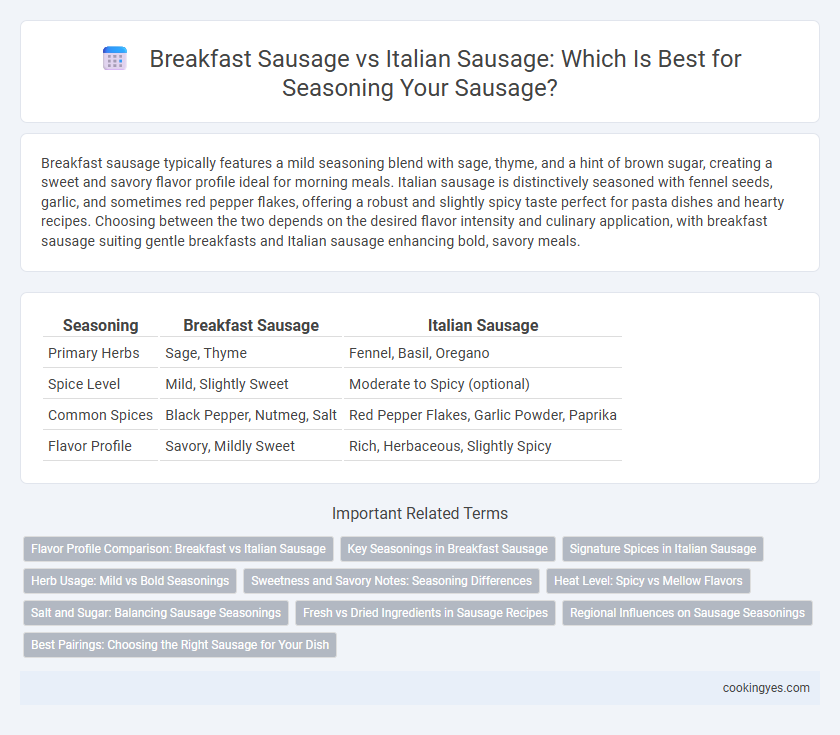Breakfast sausage typically features a mild seasoning blend with sage, thyme, and a hint of brown sugar, creating a sweet and savory flavor profile ideal for morning meals. Italian sausage is distinctively seasoned with fennel seeds, garlic, and sometimes red pepper flakes, offering a robust and slightly spicy taste perfect for pasta dishes and hearty recipes. Choosing between the two depends on the desired flavor intensity and culinary application, with breakfast sausage suiting gentle breakfasts and Italian sausage enhancing bold, savory meals.
Table of Comparison
| Seasoning | Breakfast Sausage | Italian Sausage |
|---|---|---|
| Primary Herbs | Sage, Thyme | Fennel, Basil, Oregano |
| Spice Level | Mild, Slightly Sweet | Moderate to Spicy (optional) |
| Common Spices | Black Pepper, Nutmeg, Salt | Red Pepper Flakes, Garlic Powder, Paprika |
| Flavor Profile | Savory, Mildly Sweet | Rich, Herbaceous, Slightly Spicy |
Flavor Profile Comparison: Breakfast vs Italian Sausage
Breakfast sausage features a mild, savory flavor with hints of sage, black pepper, and a touch of sweetness, creating a comforting and subtle seasoning ideal for morning meals. Italian sausage boasts a robust and aromatic profile, characterized by fennel seeds, garlic, red pepper flakes, and sometimes anise, producing a spicier and more complex taste suited for hearty Italian dishes. The distinction in seasoning highlights breakfast sausage's gentle warmth versus Italian sausage's bold, herbaceous intensity, catering to different culinary applications.
Key Seasonings in Breakfast Sausage
Breakfast sausage features key seasonings such as sage, thyme, and black pepper, creating a mild, savory flavor profile ideal for morning meals. In contrast, Italian sausage predominantly uses fennel seeds and garlic, offering a bolder, herby taste suited for pasta and pizza. The distinct seasoning blends define their culinary applications and regional palate preferences.
Signature Spices in Italian Sausage
Italian sausage is distinguished by its signature spices, primarily fennel seeds and anise, which impart a sweet, aromatic flavor profile unique to Italian cuisine. In contrast, breakfast sausage emphasizes sage, thyme, and black pepper, creating a savory and slightly herbaceous taste tailored for morning meals. The bold fennel in Italian sausage sets it apart, making it a preferred choice for robust pasta sauces and grilled dishes.
Herb Usage: Mild vs Bold Seasonings
Breakfast sausage features mild seasoning with herbs like sage, thyme, and a touch of black pepper, creating a subtle, savory flavor profile. Italian sausage incorporates bold herbs such as fennel seeds, crushed red pepper, and garlic, delivering a robust and spicy taste. The difference in herb usage defines the distinct flavor characters, with breakfast sausage leaning toward gentle, comforting notes and Italian sausage embracing a more intense, aromatic seasoning.
Sweetness and Savory Notes: Seasoning Differences
Breakfast sausage typically features a blend of mild, sweet spices such as sage, maple, and brown sugar, creating a sweeter flavor profile that complements morning dishes. Italian sausage is characterized by robust savory herbs like fennel, garlic, and red pepper flakes, delivering a rich, spiced taste ideal for pasta and pizza. The contrast in sweetness and savory notes arises from breakfast sausage's emphasis on sweet warmth versus Italian sausage's bold, aromatic seasoning.
Heat Level: Spicy vs Mellow Flavors
Breakfast sausage typically features a mild to moderate heat level, seasoned with sage, black pepper, and a hint of sweetness to create mellow flavors ideal for breakfast dishes. Italian sausage is characterized by a spicier profile, often infused with crushed red pepper, fennel seeds, and garlic, delivering a robust and bold flavor that enhances Italian cuisine. The choice between the two depends on whether a subtle, comforting taste or a vibrant, spicy kick is desired in the meal.
Salt and Sugar: Balancing Sausage Seasonings
Breakfast sausage typically contains a higher amount of salt and sugar to create a sweeter, milder flavor profile, enhancing breakfast dishes with a balanced savory-sweet taste. Italian sausage seasoning emphasizes salt alongside herbs like fennel and garlic, with minimal sugar to preserve its robust, savory character and complement pasta or pizza. Understanding the precise salt-to-sugar ratio is crucial for achieving the desired flavor harmony in each sausage style.
Fresh vs Dried Ingredients in Sausage Recipes
Breakfast sausage typically features fresh herbs like sage and thyme, combined with fresh spices such as ground black pepper and fresh garlic, creating a mild and savory flavor profile. Italian sausage relies more heavily on dried seasonings such as fennel seeds, crushed red pepper flakes, and dried oregano, which contribute to its robust and slightly spicy taste. The use of fresh versus dried ingredients significantly influences the aroma, texture, and overall seasoning intensity in sausage recipes.
Regional Influences on Sausage Seasonings
Breakfast sausage typically features a mild, savory blend of sage, black pepper, and thyme, reflecting Midwestern and Southern American regional preferences for hearty, comforting flavors. Italian sausage seasoning emphasizes fennel, anise, and red pepper flakes, rooted in Mediterranean influences and traditional Italian culinary practices. These distinct seasoning profiles demonstrate how regional tastes and cultural heritage shape the unique flavor identities of breakfast and Italian sausages.
Best Pairings: Choosing the Right Sausage for Your Dish
Breakfast sausage features a mild, savory blend of sage, black pepper, and maple notes, making it ideal for pairing with eggs, pancakes, and creamy grits. Italian sausage is seasoned with fennel, garlic, and red pepper flakes, offering a robust flavor profile perfect for tomato-based pasta dishes, pizzas, and hearty stews. Selecting the right sausage depends on balancing mild versus spicy seasoning to complement the overall taste and texture of your meal.
Breakfast sausage vs Italian sausage for seasoning Infographic

 cookingyes.com
cookingyes.com